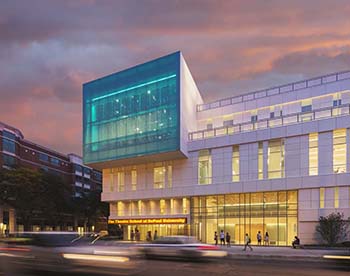DePaul’s Theatre School Achieves LEED Gold
 CHICAGO — The Theatre School at DePaul University achieved LEED Gold certification earlier this month, becoming Chicago’s first performing arts building to achieve that level of certification.
CHICAGO — The Theatre School at DePaul University achieved LEED Gold certification earlier this month, becoming Chicago’s first performing arts building to achieve that level of certification.
The 165,000-square-foot Theatre School debuted in time for the 2013-2014 school year. The facility has been in development since 2001, but the school had needed a proper facility for decades, said John Culbert, dean of the Theatre School.
For more than 30 years, the Theatre School’s “temporary” home has been a former elementary school with additional offices and classrooms in a nearby, reconverted nunnery. The new facility — designed by joint venture New Haven, Conn.-based Pelli Clarke Pelli Architects and Cannon Design, with offices in Chicago — now incorporates a variety of classroom and theater spaces located under one roof.
The first goal of the project was to build a facility that could support the quality level of training available to students at what is considered one of the top professional theater conservatory programs in the U.S. The second goal was to provide a venue that engages the community. “We were [performing] in all kinds of venues but not on the campus, which was not an effective way to engage the DePaul community or our neighbors, Culbert said.
The new five-story school features two theaters, the 250-seat Fullerton state theater and the 100-seat black box Healy theater, as well as 10 acting laboratories and three dedicated rehearsal spaces, each sized to mimic the dimensions of the school’s three different stages (the two new ones and the 1,325-seat Merle Reskin Theatre, where DePaul students continue to perform).
The greatest challenge for the project was that it was located on a tight space for how much the program required. Both space restraint issues and a height restriction in the neighborhood posed problems in terms of making sure each space had acoustical separation.
“The building is tall for a theater building, so there was a lot of careful stacking of spaces,” said Robert Shook, founding partner of Chicago-based Schuler Shook, which served as the theater planning consultant. “A lot of that had to be done with the notion of acoustical separations in mind. It was very important that noise not get transmitted. The Pelli office spent an inordinate amount of time coordinating all of the things that live in the ceilings of these spaces to get as much efficiency to the height of the building as they could.”
The facility features green building elements such as frit glass throughout the building, daylighting elements and a green roof. An interior courtyard, as well as rooftop courtyards, bring light, views and air into the offices and design studios, which is atypical of a theater school.
Perhaps the best example of daylighting is in the fourth-floor Healy theater, which features a glass wall with views of downtown Chicago. The atypical window wall provides light during rehearsals and will possibly be incorporated into future productions, but a system of curtains and shades also darkens the theater when necessary.
“Due to the outstanding efforts of the design and commissioning team, and the project’s contractor, we were awarded LEED Gold,” said Bob Janis, vice president for facility operations at the university, in a statement. “This is no small feat with a building that contains so many large volume spaces and operates long hours.”
